Pushkin Museum
Государственный музей изобразительных искусств имени А. С. Пушкина | |
 Pushkin Museum of Fine Arts | |
 Location within Moscow | |
| Location | Moscow |
|---|---|
| Coordinates | 55°44′50″N 37°36′18″E / 55.74722°N 37.60500°ECoordinates: 55°44′50″N 37°36′18″E / 55.74722°N 37.60500°E |
| Director | |
| President | Irina Antonova |
| Website | pushkinmuseum |
The Pushkin State Museum of Fine Arts (Russian: Музей изобразительных искусств имени А. С. Пушкина, abbreviated as Russian: ГМИИ) is the largest museum of European art in Moscow, located in Volkhonka street, just opposite the Cathedral of Christ the Saviour. The International musical festival Sviatoslav Richter's December nights has been held in the Pushkin Museum since 1981.
Etymology[]
Despite its name, the museum has no direct association with the Russian poet Alexander Pushkin, other than as a posthumous commemoration. The facility was founded by professor Ivan Tsvetaev (father of the poet Marina Tsvetaeva). Tsvetaev persuaded the millionaire and philanthropist Yuriy Nechaev-Maltsov and the architect Roman Klein of the urgent need to give Moscow a fine arts museum. After going through a number of name changes, particularly in the transition to the Soviet era and the return of the Russian capital to Moscow, the museum was finally renamed to honour Pushkin in 1937, the 100th anniversary of his death.
Building[]
The building of the Pushkin State Museum of Fine Arts was designed by Roman Klein and Vladimir Shukhov. Construction lasted from 1898 until early 1912, with Ivan Rerberg heading structural engineering effort on the museum site for the first 12 years.
In 2008, President Dmitri A. Medvedev announced plans for a $177 million restoration.[1] A 22 billion rubles ($670 million) expansion, developed by Norman Foster in collaboration with local architectural firm Mosproject-5, was confirmed in 2009, but became mired in disputes with officials and preservationists and concern grew that it would not be completed on schedule for 2018. After Moscow's chief architect Sergei Kuznetsov issued an ultimatum, demanding that Foster take a more active role in the project and prove his commitment by coming to the Russian capital within a month, Norman Foster's firm resigned from the project in 2013.[2] In 2014, Russian architect Yuri Grigoryan, and his firm Project Meganom, were chosen to take over the project. Grigoryan's design provides new modern buildings and, following the protest of heritage groups who campaigned to save the pre-revolutionary architecture, preserves the historic 1930s gas station near the Pushkin's main building inside a glass structure.[3]
Collection[]
The holdings of the Pushkin State Museum of Fine Arts currently include around 700,000 paintings, sculptures, drawings, applied works, photographs, and archaeological and animalistic objects. The Department of Manuscripts houses documents on the museum's history; the scientific and epistolary heritage of its founder Ivan Tsvetaev (1847–1913), other museum workers, famous art historians, and artists; and archives from other museums that are also included in the Pushkin Museum holdings. The museum owns studios for research and restoration works and a Scientific Library.
Painting[]

The earliest monuments from the museum collection are pieces of Byzantine art: mosaics and icons. The early stage of development of Western European painting is represented by a relatively small, but very impressive, collection of Italian Primitives. The hall of early Italian art was opened on October 10, 1924, but the first original paintings were presented to the Alexander III Fine Arts Museum in 1910 by Mikhail Schekin (1871–1920), the Russian consul in Trieste, and include unique Old Master works such as painting by Giambattista Pittoni. After 1924, many paintings from Moscow and St. Petersburg state-owned and private collections were provided to the museum. These were artworks by Western European painters from the Rumyantsev Museum (Moscow), as well as the private collections of Sergei Tretyakov (1834-1892), the Yusupovs, the Shuvalovs, Henri Brocard (1836-1900), Dmitry Schukin (1855-1932), and other Russian collectors. Pieces provided by the State Hermitage were of particular importance. However, the gallery was completed only in 1948, when artworks by French painters of the late nineteenth and early twentieth centuries were transferred from the State Museum of New Western Art.
Graphic art[]
The Department of Prints and Drawings was founded in 1924, when the museum received the holdings of the Printing Cabinet of the Moscow Public and Rumyantsev Museum. In 1861, Alexander II made a valuable gift to the Printing Cabinet: the Moscow Public and Rumyantsev Museum received more than 20,000 prints from the Hermitage. Later, the Department received a number of private collections from Dmitry Rovinsky (1824-1895) (Russian prints), Nikolay Mosolov (1846-1914) (etchings by Rembrandt, drawings by Dutch masters of the 17th century), and Sergey Kitaev (1864-1927) (Japanese prints). During the Soviet period, the Department's holdings were increased by means of gifts, acquisitions, and transfers from other museums (the State Hermitage, St. Petersburg; the State Historical Museum, Moscow; and the State Museum of New Western Art, Moscow). Today, the Department of Prints and Drawings is a solid collection of graphic art pieces that includes around 400,000 prints, drawings, books with prints, posters, pieces of applied graphics, and bookplates. These were created by masters of Western Europe, America, Russia, and Eastern countries from the 15th century to modern day. The collection includes works by famous artists such as Albrecht Dürer, Rembrandt, Rubens, Renoir, Picasso, Matisse, Karl Bryullov, Ivanov, Favorsky, Deyneka, Utamaro, Hokusai, and Hiroshige.
Sculpture[]
The collection of Western European sculptures includes more than 600 pieces. The museum has expanded its holdings over the years and currently owns artworks from the 6th-21st centuries. The first artifacts presented to the Museum of Fine Arts were sculptures from Mikhail Schekin's collections. After the revolution, the museum received many sculptures from nationalized collections. In 1924, a few painting halls were opened in the museum. The first original pieces found their places there. Gradual acquisition of original sculptures became possible after 1924, when the museum separated from Moscow University and started to work independently as a museum of Western European art. A special Sculpture Department was founded, which received artworks from the dissolved Rumyantsev Museum, the museum of the former Stroganov School (Moscow State Stroganov Academy of Industrial and Applied Arts), the Museum of Furniture (Moscow), and some private collections (of Dmitry Schukin, Ilya Ostroukhov (1858-1929), Osip Braz (1873-1936), and others). As a result, the collection was enriched by pieces of polychrome wooden sculpture of the 15th and 16th centuries, bronze sculptures of the 16th and 17th centuries, and works by French masters of the 18th century: Lemoyne, Caffieri, Houdon, and Clodion. After the State Museum of New Western Art was closed in 1948, the Pushkin Museum received more than 60 sculptures, including artworks by Rodin, Maillol, Bourdelle, Zadkine, Archipenko, etc. The collection of modern sculptures was formed through gifts from sculptors themselves.
Collection of decorative art pieces (Department of the Old Masters)[]
The collection of decorative art pieces from Europe includes around 2,000 items. The earliest are from the Middle Ages, and the set as a whole is very diverse. It includes art pieces made from wood and bone, base and precious metals, stone, textiles, ceramics, and glass. Of particular interest are the collection of ceramics that includes all major types of artworks and the collection of furniture.
Archaeological collection[]

The Museum of Fine Arts was intended primarily as a museum of classical arts. Ancient artifacts were the core and the main components of its collection, and the Department of Antiquity was one of the three major scientific departments. Its founder and director, Ivan Tsvetaev (1847-1913), was an expert in ancient art, as were his closest associates, Vladimir Malmberg (1860-1921) and Nikolay Scherbakov (1884-1933).
The ancient collection of the Pushkin State Museum currently includes more than 37,000 pieces, including many fragments of ancient artifacts. It consists of around 100 architectural fragments; more than 300 ancient sculptures; around 2,500 painted vessels from Cyprus, Ancient Greece, and Southern Italy; around 2,300 terracotta pieces; more than 1,300 bronze pieces; around 1,200 applied works (mostly glass); more than 100 carved stones; around 30 fragments of wall paintings; and two mosaics.
Egypt[]
Most of the objects presented in Hall No. 1 have been on display since the museum opening in 1912 and come from the collection of Vladimir Golenishchev (1856-1947). It is one of the world's best private collections of Ancient Egyptian art, acquired by the museum in 1909. This collection of around 8,000 objects was the first significant collection of original pieces of the Fine Arts Museum.
In 1913, the museum acquired a collection of items, including a plate with a scene of mourning known as Mourners. A few precious gifts were made by Yury Nechaev-Maltsov (1834-1913): beautiful Fayum mummy portraits, a golden diadem, and a bronze statue of walking Harpocrates. After the Great October Socialist Revolution, the museum's Egyptian collection acquired exhibits from other museums and private collections. Moreover, scientists whose work was inextricably linked to the museum, such as Boris Farmakovsky (1870-1928), Tamara Borozdina-Kozmina (1883-1958), and Alexander Zhivago (1860-1940), gave their artifacts to the Department of the Ancient East. The museum's collection was significantly enriched after the acquisition of the collection of painter and art historian Nikolay Prakhov (1873-1957) in 1940. The collection included 217 pieces and previously belonged to Prakhov's father, famous Russian art historian, philologist, archaeologist, and critic Adrian Prakhov (1846-1916). Adrian Prakhov went to Egypt many times to study ancient artifacts. Later, the holdings of the Department of the Ancient East were enhanced through gifts, archaeological excavations, and regular acquisitions.
Ancient civilizations[]
The museum holdings of genuine artifacts of Southwest Asia are based on the collection of famous Russian Orientalist and Egyptologist Vladimir Golenishchev. It included more than 300 cuneiform plates and more than 200 glyptic pieces. The museum acquired the first plates in 1911, a year before its official opening. The Central Asian collection of the Department of the Ancient East is represented by clay figurines from the end of the 1st millennium B.C. and the beginning of the 1st century A.D. (fragments of a female and a male figurines), acquired in the mid-1990s. These pieces come from the territory of Margiana (modern southeastern Turkmenistan) and are great examples of authentic local art and the influence of antique and even older Eastern traditions.
Antiquity[]
The antique collection of the Pushkin State Museum of Fine Arts includes many genuine artifacts: more than 1,000 vessels, small plastic pieces, and sculptures. The first items were provided by the Cabinet of Fine Arts and Antiquities of Moscow University. Beautiful examples of Ancient Greek painted ceramics were transferred in the 1920s from the Historical Museum, the Museum of Ceramics, the Tretyakov Gallery, and the Rumyantsev Museum. Many artifacts were found during long-term archaeological expeditions to ancient cities, such as Panticapaeum and Scythian Neapolis (Crimea), as well as Phanagoria (the Taman Peninsula).
Tsvetaev’s collection of casts[]
The collection of casts and copies, typical for European museums of the nineteenth century, is unique today in its preservation and consistency. Initially, its holdings were determined by the status and interests of art history in the late nineteenth century. The collection of casts is currently displayed in the historical building in just one-third of the halls that Tsvetaev intended for this purpose. Most of this collection is still open to the public, as approximately 1,000 pieces can be viewed at the . About half of the 22 exposition halls of the museum, designed and created by Ivan Tsvetaev, are dedicated to the ancient plastic arts. The list of artifacts for exhibition was prepared with the help of famous antiquity researcher Vladimir Malmberg. The carefully selected set of casts made from Creto-Mycenean, Ancient Greek, and Roman sculptures was supplemented with innovative electrotype copies that fully reproduce jewellery, small plastic pieces, and weapons. The casts and electrotype copies have created a pictorial and full understanding of the development of ancient art.
The second part of the collection of casts and copies demonstrates the milestones of Western European art development from early Christianity to the Renaissance. The art of Michelangelo is fully represented in the exposition. The sculptures are supplemented with copies of architectural constructions and details. Both the exhibits and the halls, which were designed according to the concept of reconstructing architectural forms, served a unified educational goal.
With a similar cohesiveness, Tsvetaev wanted to present plastic art of the modern era and complete the collection with casts made from contemporary sculptures, where Auguste Rodin’s works would take the central place. Unfortunately, the last part of his plan was not implemented due to a lack of funding after a fire broke out during construction. Some casts and copies from the museum collection are the only genuine reproduction of artifacts lost during the World Wars.
Numismatic collection[]
Today, the holdings of the Numismatics Department of the Pushkin State Museum of Fine Arts form a collection in excess of 200,000 items and 3,000 volumes of the special library. It was started at Imperial Moscow University. In 1888, the collection was divided and formed the basis for the major numismatic collections of Moscow that belonged to the Historical Museum and the Alexander III Fine Arts Museum.
Since 1912, objects of ancient and Western European numismatics from the university collection were transferred to the Sculpture Department of the Fine Arts Museum and mostly kept packaged. By June 1925, museum custodians had grouped together a number of cases with coins, medals, and casts and created the Numismatic Cabinet located on the balcony of the White Hall. In 1945, the museum's Numismatic Cabinet became an independent department. It includes archaeological material from Central Asia, such as a hoard of Kushano-Sasanian coins acquired in 2002[4]
Today,[when?] the Numismatics Department of the Pushkin State Museum of Fine Arts owns a variety of objects including coins, medals, orders, stamps, paper monetary notes, engraved gems and casts.
Museum Quarter[]
Implementation of the concept for development of the Pushkin State Museum of Fine Arts and its transformation into a museum quarter between Volkhonka Street, Kolymazhny Lane, and Bolshoy and Maly Znamensky Lanes began in 2014 (see Museum Quarter website). The idea of the Museum Quarter on Volkhonka Street belonged to Ivan Tsvetaev, a philologist and art historian, and the founder and first director of the museum. Museum expansion projects have been proposed since right after its opening.
The work on the Museum Quarter of the Pushkin State Museum of Fine Arts started in the late 2000s in recognition of the 100th anniversary of the museum. In 2008, the government of the Russian Federation allocated funds for this project. From 2014 to 2019, museum buildings underwent reconstruction and adaptation, and the Depository, Restoration and Exhibition Center is under construction.
In 2019–23, the Main Building of the Pushkin State Museum of Fine Arts will be reconstructed. After the reconstruction, nine museums will operate in the Museum Quarter. Spaces will be created in every museum for permanent and temporary exhibitions, depositories, shops, lecture halls, public zones, and cafés.
Gallery[]

Annunciation by Sandro Botticelli, c. 1495-1498
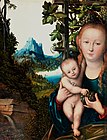
Madonna and a Child by Lucas Cranach the Elder, c. 1520

Apparition of the Sybil to the emperor Augustus by Paris Bordone, c. 1550
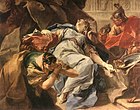
Death of Sophonisba by Giambattista Pittoni, first half of the 18th century
Portrait of actress Jeane Samary by Pierre-Auguste Renoir, 1877
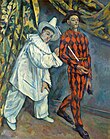
Fastnacht (Mardi Gras) by Paul Cézanne, 1888
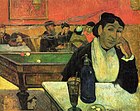
The Night Cafe, Arles by Paul Gauguin, 1888

The Red Vineyard by Vincent van Gogh, 1888, only van Gogh painting sold in his lifetime

Yvette Guilbert by Henri de Toulouse-Lautrec, 1894
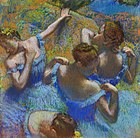
Blue Dancers by Edgar Degas, 1897

Acrobat on a Ball by Pablo Picasso, 1905
References[]
- ^ Lawrence Van Gelder (May 9, 2008), Pushkin Museum Overhaul Planned New York Times.
- ^ Sophia Kishkovsky (August 16, 2013), Norman Foster resigns from Pushkin Museum expansion Archived 2013-08-17 at the Wayback Machine The Art Newspaper.
- ^ Sophia Kishkovsky (July 2, 2014), Pushkin hires Moscow architect for expansion Archived 2014-07-14 at the Wayback Machine The Art Newspaper.
- ^ Smirnova, N (1996). "Vasudeva Imitations and Kushano Sasanian Coppers from Turkmenistan". Moneti i Medali. pp. 130–133.
Further reading[]
- William Craft Brumfield. The Origins of Modernism in Russian Architecture (Berkeley: University of California Press, 1991) ISBN 0-520-06929-3
External links[]
| Wikimedia Commons has media related to Pushkin Museum. |
- Official website
- Museum Quarter official website
- The Morozov/Shchukin's collections, morozov-shchukin.com
- Pushkin Museum History, SmashPixels.com
- Pushkin Museum of Fine Arts (Moscow)
- The Opening of the Museum, English.tsvetayeva.com
- Photo (1024x768), otdihinfo.ru
- Angela Craciun with Irina Antonova
- Pushkin Museum
- Art museums and galleries in Moscow
- Cultural heritage monuments in Moscow
- Tourist attractions in Moscow
- Roof structures by Vladimir Shukhov
- Egyptological collections in Russia
- Art museums established in 1912
- 1912 establishments in the Russian Empire
- Museums of ancient Greece in Russia
- Museums of ancient Rome in Russia
- Museums of Ancient Near East
- Plaster cast collections
















